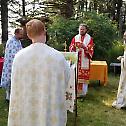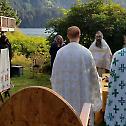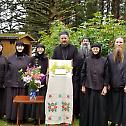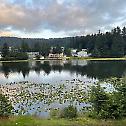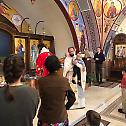Visit to Spruce Islands and Anchorage in Alaska 2021
Pilgrimage to Orthodox Alaska, August 16-20, 2021
The first Serbian immigrants came to Alaska during the Gold rush which occurred at the end of 19th and beginning of the 20th century. Alaska is considered the Cradle of Orthodoxy on this continent. In addition to the great work of the Russian Orthodox missionaries, most especially St. Herman, the Serbs contributed by erecting the Church of St. Sava in Douglas, Alaska with the help of Fr. Sabastian Dabovic.
The Serbian mission parish of Venerable Peter of Korish in Anchoraga, was established by in 1992. Besides the descendants of early immigrants and some newer immigrants, the church serves recent refugees who fled the war and persecution in the former Yugoslavia. In spite to a severe climate and harsh weather changes, this small Serbian Orthodox community which includes 30 to 50 souls is determined to stay and keep the church alive. Towards that goal, two parishioners, Ljubisa and Lana Gavrilovic, donated property very close to downtown Anchorage.
Initially the Divine Liturgy was served once every two years, but, since the enthronement of Bishop Maxim, the Liturgy is served two times a year until the conditions are created for a permanent priest. This mission is comprised of about 40 Serbs living in the area, but does not have its own church.
On Saturday, August 20, Vladika Maxim celebrated Divine Liturgy at the Greek Orthodox Church of The Holy Transfiguration, with fathers Blasko and Vasili and the congregation of the Venerable Peter of Korish Serbian Mission Parish of Anchorage. In a liturgical baptism the little Gabriel Nedjo was immersed into the sanctified water and chrismated by Bishop Maxim. Later that day, the family Spaic and Rodrigez gathered with the clergy for a sumptive feast before the returning of Bishop Maxim and Fr. Blasko Paraklis to California. Bishop Maxim also met with the newly elected Bishop of Alaska Alexis and gave him copies of the new Sebastian Press titles.
Earlier that week, Bishop Maxim together with Presbyter Blasko Paraklis visited Kodiak and Spruce Island. Spruce Island, known as the “New Valaam”, is where St. Herman of Alaska lived from 1808-1818 in a life of prayer and strict asceticism. Although the original house he lived in no longer remains, a new house and church were built on the site of his repose. A miraculous, healing freshwater spring flows nearby. The island is also home to the monks of the St. Michael Skete, under the jurisdiction of Bishop Maxim. Three monks are currently living in the monastery, celebrating the daily cycle of services and farming and fishing for sustenance. The monks boast an impressive vegetable garden and preserve whatever fish they catch for the cold winter months. The monastery does not have running water or refrigeration. Heating is obtained by burning the wood they must chop themselves and store in a small shed for the winter. It should be noted that the hard physical work is amplified by the very steep island terrain which is wet and rocky in the warm season and covered by thick snow and slippery ice in the cold season.
While they stayed at St. Michael’s Skete, the Bishop and Fr. Blasko visited also the St. Nilus Skete, dedicated to St. Nilus of Sora, which is settled on a small island about ten minutes away by boat.
The visitors participated in the services and fished every day with the monks where they caught several halibuts and cod fish! Fellowship followed the meals and the group engaged in traditional folk singing in Serbian, Greek, English and Italian.
On Thursday, August 19, the festal Divine Liturgy for the Holy Transfiguration at St. St. Nilus Island was led by Bishop Maxim with the concelebration of priests Blasko, Andrew, Ephraim and Michael. The traditional blessing of fruits and grapes followed the liturgy.
Home to a myriad of birds- eagles, warblers, thrushes, woodpeckers, and puffins- St. Nilus Island, as it’s known, is also home to five nuns, also under the Western American Diocese of the Serbian Orthodox Church. Like St. Michael’s Skete, theirs too is very rustic and they live off of the land. The sisters produce and sell prayer ropes as a means of supporting themselves. They are in the process of building a new winter house and upgrading their current cells in order to be able to better survive the harsh winters and to accommodate future pilgrims. While many may find the conditions here rough, the monastics truly appreciate the natural beauty and splendor of the area, and as well as the solitude it provides so that they can experience the “royal path” and pray for those of us living in the world.
Source: Western American Diocese of the SOC

